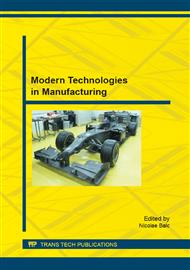[1]
S. Maričić, D.K. Pavičić, M. Perinić, V. Lajnert, The use of technological documentation in vestibuloplasy fixture plate production, Medicina Fluminensis 47 (3) (2011) 294-298.
Google Scholar
[2]
Information on http: /www. raeng. org. uk/publications/reports/additive-manufacturing.
Google Scholar
[3]
L. N. Marcincinova, J. N. Marcincin, Selected testing for Rapid Prototyping technology operation, Applied Mechanics and Materials 308 (2013) 25-31.
DOI: 10.4028/www.scientific.net/amm.308.25
Google Scholar
[4]
C. S. M. Borzan, M. C. Dudescu, K. A. Elghany, V. Ceclan, P. Berce, Analysis of mechanical properties of Selective Laser Sintered polyamide parts obtained on different equipment, Materiale Plastice 52 (1) (2015) 39–42.
Google Scholar
[5]
A. Pilipovic, I. Drstvensek, M. Sercer, Mathematical model for the selection of processing parameters in Selective Laser Sintering of polymer products, Advanced in Mechanical Engineering (2014) 1-9.
Google Scholar
[6]
P. Bere, P. Berce, O. Nemes, Phenomenological fracture model for biaxial fiber reinforced composite, Composites Part B: Engineering International Journal 43 (2012) 2237–2243.
DOI: 10.1016/j.compositesb.2012.01.073
Google Scholar
[7]
M. Ridzon, A. Zavacka, Effect of drawing tubes without interoperation recrystallization annealing on the orientation of boundaries grain – longitudinal direction, Applied Mechanics and Materials 421 (2013) 329-333.
DOI: 10.4028/www.scientific.net/amm.421.329
Google Scholar
[8]
Z. Buna, D. Popescu, F. Popister, I. Badiu, Reverse Engineering methods for vintage car components re-Creation, International Conference on Production Research and 3RD International Conference on Quality and Innovation in Engineering and Management (ICPR-AEM 2014) 49–54.
Google Scholar
[9]
F. Popister, D. Popescu, D. Hurgoiu, A new method for using Reverse Engineering in case of ceramic tiles, Quality – Access to success - Supplement (2012) 409–412.
Google Scholar
[10]
L. Morovic, P. Pokorny, Optical 3D scanning of small parts, Advanced Materials Research 468-471 (2012) 2269-2273.
DOI: 10.4028/www.scientific.net/amr.468-471.2269
Google Scholar
[11]
V. Savani, R.V., Rao, D.P., Vakharia, Optimal weight design of a gear train using particle swarm optimization and simulated annealing algorithms, Mechanism and Machine Theory 45 (3) (2010) 531–541.
DOI: 10.1016/j.mechmachtheory.2009.10.010
Google Scholar
[12]
P. Bere, C. Neamtu, Methodology for evaluate the form deviations for formula one nose car, Open Engineering 4 (2) (2014) 148–154.
DOI: 10.2478/s13531-013-0158-x
Google Scholar
[13]
A. Weigang, L. Weiji, Interactive multi-objective optimization design for the pylon structure of an airplane, Chinese Journal of Aeronautics 20 (6) (2007) 524–528.
DOI: 10.1016/s1000-9361(07)60077-6
Google Scholar
[14]
Information on http: /www. slm-solutions. com/cms/upload/pdf/120923_SLM_Materialien. pdf.
Google Scholar


